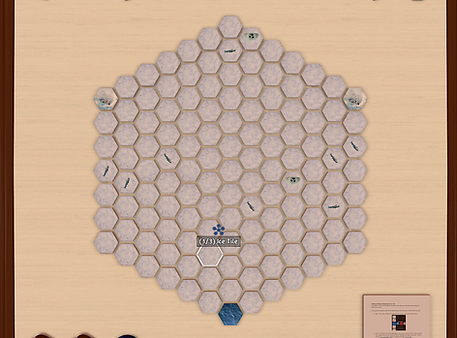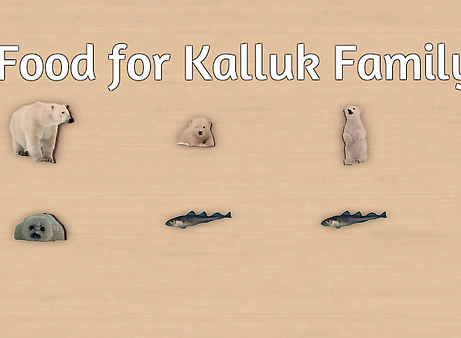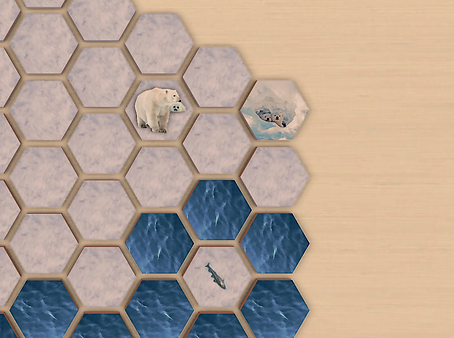

My Role
Designer
Designed the game by myself
Developer
Developed the Tabletop Simulator version myself
The Polar Bear is a tabletop collaboration game where two players play as mommies of two polar bear families, trying to collect food and carry them back home before the ice melts away and food disappears.
In this game, players share a common goal, and work together to collect enough food for two families to survive. Click here to see my thoughts on designing a meaningful play experience.
The game is designed by myself in Tabletop Simulator. Click here to play the game on Steam.
Game Board

The Initial Ice Board

Ice Melting to Sea

Cubs at Home

Mommy Bear Catching Food

Collecting Enough Food

Ice Melting and Food Disappearing
Development Process
Inspration

The initial idea was inspired by a documentary named “Our Planet”. In the polar bear episode, there was a scene of a polar bear swimming in the water to the ice that is far away. I was very sad when I saw that polar bears are losing their places to live because of global warming, and I decided to make a game about global warming and how that affects polar bear’s life.
I couldn’t find the photo of that scene, so I use a similar photo here on the left.
Iteration 1 and Playtest 1

In the first iteration, two players play as the parents of two cubs and need to collect enough food for the whole family to survive. They take turns and start to move from the home tile. In player turn, each player has two Action Points (AP), and 1 AP can perform actions such as move one tile, harvest fish/seal as food resources and drop the food at home. After their movement, players need to roll the six sided-dice to decide how many ice tiles have melted to the sea in this turn. Players need to work together and collect enough food for the family.
There are several critical observations that I found during the playtest. Main issues are:
1. Players are not flipping the ice tiles after each player turns. Instead, they flip the tiles after two players finish one their turn. As a result, the ice tiles are not melting as fast as I originally planned, and players are not getting the sense of urgency because they are not losing lands and foods.
- Why: The rule is unclear to the players, and players misunderstand the rules
- How to fix: Revise the rule, highlight in the rulebook to emphasize this mechanic.
2. There is no starting point for the melting ice, and players always start melting the ice in the farthest tile. This also reduces the sense of urgency because the surrounding ice is enough for players to move and collect food.
- Why: There is no specific rule that sets the starting point.
- How to fix: Pick a starting tile and let the players to melt the ice around this tile
3. Not enough collaboration happens. The mommy bear and the daddy bear are collecting food themselves. The only collaboration needed is when hunting the seals, which requires both players to hunt together.
- Why: There is no reason for them to collaborate. Even though their goal is to bring food back to the same home, the actions they need to do are separate and mostly individual.
- How to fix: Add some new mechanics to encourage collaboration.
4. Players express that they want to see prey movement, as it's not reasonable it the preys are always staying at one tile and not avoid the upcoming hunts.
- Why: It is not reasonable that the preys are not trying to avoid the hunts. This also reduces the sense of hunting.
- How to fix: Add a prey movement mechanic. Maybe when the polar bears are near the preys, the preys notice the bears and may or may not escape.
Iteration 2 and Playtest 2

In this iteration, I revised the rule and made some changes such as adding the seal movement and set the ice melt starting point. A big change was that, instead of one polar bear family, there are two families living on different tiles. Players still need to collaborate for the two families to survive, and because the two families are living in different locations, it is likely that one family would get less food resources around their home. As a result, another polar bear would need to offer the help in order to collect enough food before the ice melts away.
This design change turns out to be successful. Players started to collaborate more, and it’s creating more sense of urgency because the destinations are separate on two tiles that are far away.
Meaningful Play
In this game, my goal is to let the players feel that they are under pressure of losing food and getting starved because of environmental changes that are out of their control, acknowledging the consequences of global warming and how this affects the polar bear family.
Games are not just entertainment. Games can create meaningful and educational experience that could give players a strong impact. My goal in the future is to create more games like this that provides a meaningful experience.